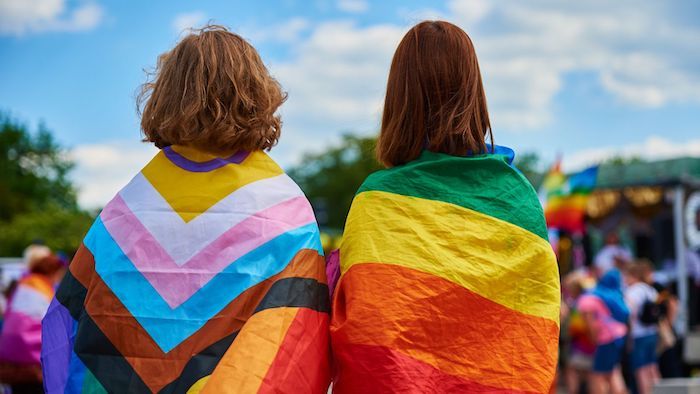
Just How Much Has LGBTQ+ Representation Grown in Middle Grade In The Last Half Decade?
The media is a purveyor of what our culture sees as normal and positive, and that is why pop culture tropes such as “Bury Your Gays” have had such pushback. Though focused on the medium of film, many of the points made in The Celluloid Closet documentary — and the book by the late Vito Russo — are still apt for a variety of media portrayals of queerness. For one, historian Richard Dyer explains, “Our ideas about who you are don’t just come from inside you. They come from the culture […] what it means to be a man or a woman, what it means to have sexuality.”
This is especially true for middle grade children, as it is around this time that they begin to question and analyze their gender presentation and sexual orientation. When you’re a kid, you don’t have the life experience yet that might allow you to realize that media isn’t entirely accurate, that queer people live all sorts of lives and have incredible experiences of their own. The lack of representation can be isolating. Again, The Celluloid Closet has some eloquent examples of this, including a quote by Harvey Fierstein, “That hunger I felt as a kid looking for gay images was to not be alone.” Additionally, these last few years have been coo-coo bananas with book bans, so having the book industry publish books like these helps to push back against that ignorance and hate by reminding kids that they are not alone.
My coming-to-terms-with-coming-out-journey took place between 13 and 15 years old; as a 1990s teen, we didn’t have much for positive representation in media. For instance, female bisexuality was still very consistently being used as a plot complication and marketing ploy. The only lesbian book I remember reading was 1982’s Annie on My Mind. Nancy Garden’s novel is about two teen girls, Annie and Liza, who fall in love and deal with the consequences of being outed by a school administrator.
Comparatively, kids growing up in 2023 have many options for queer kidlit. A small batch of titles from the past year includes Juniper Harvey and the Vanishing Kingdom by Nina Varela, The Civil War of Amos Abernathy by Michael Leali, Tiger Honor by Yoon Ha Lee, Ellie Engle Saves Herself by Leah Johnson, and Jamie by L.D. Lapinski.
Have Things Changed In Five Years?
In Dana Rudolph’s Mombian post A Record 190+ Books Selected for 2023 Rainbow Book List, she explains that:
[The] Rainbow Book List Committee of the American Library Association’s (ALA’s) Rainbow Round Table reviewed nearly 550 books published between July 1, 2021 and December 31, 2022, and selected more than 190 (by my count, 193) fiction and non-fiction books for toddlers through young adults, blowing away last year’s number of 122 and 2021’s 129.
Rudolph found a significant bump over the years, beginning with the 2019 Rainbow Book List — covering books published between July 2017 and December 2018.
Another article about the Rainbow Book List, written by Alec B. Chunn and Anastasia Collins for a 2023 issue of The Horn Book Magazine, the first Rainbow Book List only had 45 entries. Their post comments on the fact that, while the middle grade LGBTQ+ offerings have improved, we need fewer “firsts” and more milestones to be repeated. One example they give is the 2021 publication of This Is Our Rainbow: 16 Stories of Her, Him, Them, and Us, edited by Katherine Locke and Nicole Melleby. It’s the first and so far only queer middle grade fiction anthology.
In 2018, The Horn Book featured a post analyzing the diversity statistics put out by the Cooperative Children’s Book Center (CCBC), a respected research library of the University of Wisconsin-Madison School of Education. CCBC librarian Madeline Tyner wrote, “In 2017, of the approximately 3,700 books we received at the CCBC, we counted 136 — less than 4 percent — with significant LGBTQ+ content.” Additionally, Tyner explains, “More than three-quarters of the LGBTQ+ books we received in 2017 were fiction, and of these, most were for teens. We received very little LGBTQ+ fiction for middle grade readers.”
Thankfully, that is shifting. Though I didn’t find specific statistics available focusing on middle grade novels, as a full-time children’s librarian who specializes in LGBTQ+ fiction, I can tell you that I am finding wonderful new queer middle grade novels all the time. This is a booklist I put together last year, with fantastic books across LGBTQ+ representation and story genres. Don’t just take my word for it, either. Goodreads has a list of 36 LGBTQ+ middle grade novels published in 2023, and it’s a vast improvement from the equivalent list from 2018, which had only eight books.
The best and biggest improvement is that children’s queer fiction doesn’t exclusively focus on coming out anymore. The books run across a range of genres and styles, and LGBTQ+ kids are having their stories told amidst tales of mystery, fantasy, sci-fi, and romance. Juniper Harvey gets to have an exciting fantasy adventure while fighting for the affections of a princess — that would have blown me away to read as a kid!
While bans continue to be a problem that we need to fight against, the positive news is that it seems the publishing world is bringing us more consistent and varied LGBTQ+ representation in middle grade fiction. That’s a good start.
Want more options for queer middle grade reads? Visit resources such as I’m Here. I’m Queer. What The Hell Do I Read?, We Need Diverse Books, and LGBTQ Reads. Another wonderful resource is Mombian, which provides a database of LGBTQ+ books for kiddos that now features over 1,400 items.














